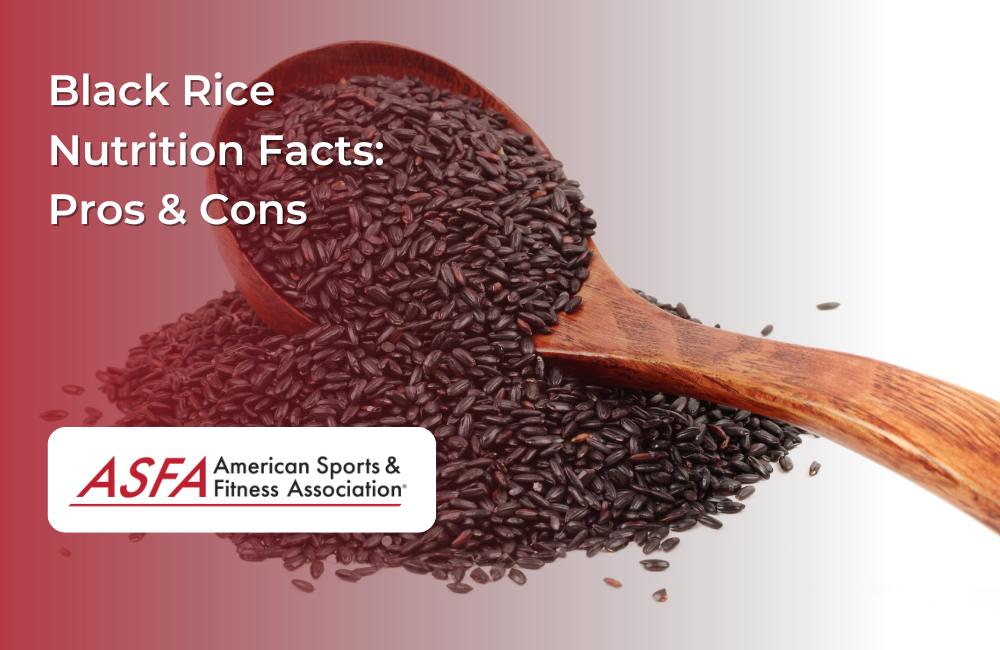Black rice, also known as forbidden rice, is a nutrient-dense whole grain with a deep purple-black color due to its high anthocyanin content (a powerful antioxidant). It is higher in protein and fiber than white rice and provides essential minerals and antioxidants, making it a superfood. However, its higher carbohydrate content and longer cooking time should be considered.
Black Rice Nutrition Facts Pros Cons: An Analysis of Its Nutritional Profile
One 1-cup (150 grams) cooked serving of black rice provides an impressive black rice nutrition profile:
-
Calories: 170-200
-
Carbohydrates: 34-45 grams
-
Fiber: 3-5 grams
-
Protein: 5-6 grams
-
Fat: 1-2 grams
-
Sugar: 0 grams
-
Vitamins and Minerals:
-
Iron: Supports oxygen transport and red blood cell production
-
Magnesium: Helps with muscle and nerve function
-
Zinc: Supports immune health and metabolism
-
Phosphorus: Important for bone health and energy metabolism
-
Antioxidants (Anthocyanins): Reduce inflammation and support heart health
The nutrition black rice offers, with its high levels of protein, fiber, and essential minerals, makes it a valuable addition to a balanced diet. Uncooked black rice should be stored in a cool, dry place to maintain its freshness and nutritional value.
Pros of Eating Black Rice
Rich in Antioxidants and Anti-Inflammatory Compounds
Anthocyanins (the same antioxidants in blueberries) help fight oxidative stress and reduce inflammation.
These antioxidants contribute to the health benefits of black rice, supporting brain health, brain function, heart health, and skin health.
Higher in Protein and Fiber Than White Rice
-
5-6 grams of protein per cup, making it a good plant-based protein source.
-
3-5 grams of dietary fiber, which helps improve digestion, prevent constipation, and support digestive health.
Supports Heart Health
-
High fiber content helps lower cholesterol levels and reduce the risk of heart disease.
-
Anthocyanins and magnesium help regulate blood pressure.
May Help Regulate Blood Sugar
-
Lower glycemic index (GI) than white rice, meaning it causes slower blood sugar spikes.
-
Fiber and protein help balance glucose absorption. Similar to purple rice, black rice has a lower glycemic index, making it a better option for blood sugar control.
Good for Weight Management
-
Higher fiber and protein content promote satiety, reducing overeating.
-
Nutrient-dense with fewer empty calories compared to refined grains.
Gluten-Free and Suitable for Many Diets
-
Naturally gluten-free, making it safe for people with celiac disease or gluten sensitivity.
Versatile in Cooking
Can be used in stir-fries, grain bowls, salads, desserts, or as a side dish, where its nutty flavor enhances the overall taste and texture.
Cons of Eating Black Rice
High in Carbohydrates
-
34-45 grams of carbs per serving, which may not be ideal for low-carb or keto diets.
-
Should be consumed in moderation by diabetics to avoid blood sugar spikes.
Takes Longer to Cook
-
Forbidden rice, also known as black rice, requires about 30-45 minutes to cook, longer than white rice.
-
Soaking it overnight can help reduce cooking time. Uncooked black rice can be soaked overnight to reduce the cooking time.
May Contain Arsenic (Like Other Rice Varieties)
-
Some rice contains trace amounts of arsenic, which can accumulate over time.
-
Rinsing and cooking black rice in excess water can reduce arsenic levels.
More Expensive Than White or Brown Rice
Considered a specialty grain, emperor's rice, also known as black rice, is more costly and harder to find than regular rice.
Conclusion
Black rice is a nutrient-dense whole grain rich in antioxidants, fiber, and protein, making it a healthier alternative to white rice with numerous benefits of black rice. However, its high carb content, longer cooking time, and potential arsenic exposure should be considered. Consuming it in moderation as part of a balanced diet allows you to maximize its benefits.
FAQs
Is black rice healthier than white rice?
Yes, black rice has more fiber, protein, and antioxidants, making it a more nutrient-dense choice.
Does black rice help with weight loss?
Yes, higher fiber and protein promote fullness, reducing calorie intake.
Is black rice good for diabetics?
It has a lower glycemic index than white rice, but portion control is important due to its carb content.
How do you cook black rice?
-
Rinse thoroughly to remove excess starch.
-
Use a 2:1 water-to-rice ratio and simmer for 30-45 minutes.
-
Soaking overnight reduces cooking time.
In traditional Chinese medicine, black rice is often praised for its health benefits.
Does black rice contain gluten?
No, black rice is naturally gluten-free.
Can I eat black rice every day?
Yes, in moderation, as part of a balanced diet alongside protein, vegetables, and healthy fats.
Is black rice better than quinoa?
-
Black rice has more antioxidants, while quinoa has more protein and all essential amino acids.
-
Both are healthy whole grains depending on dietary needs.
Where can I buy black rice?
Available at health food stores, Asian markets, and online retailers.





